What makes Ecuador one of the best countries for birdwatching in the world, bar none? Obviously, the highest species diversity per square mile doesn’t hurt. But Ecuador goes above and beyond in the service of sensational wildlife watching. How many countries do you know that have a road dedicated to birding?
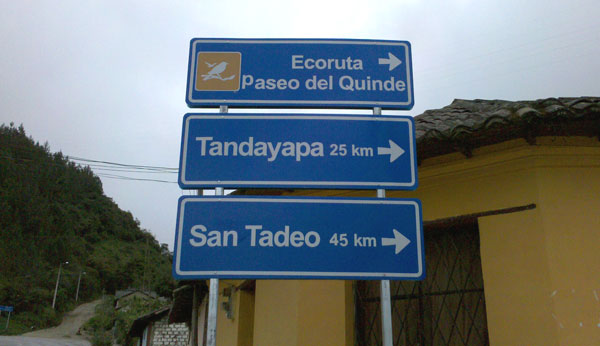
Ecoruta El Paseo del Quinde
Ecuador’s legendary Nono-Mindo Road has been rechristened the Ecoruta ‘El Paseo del Quinde’ otherwise known as The Hummingbird´s Trail or simply the Ecoroute. The Ecoroute is a pure ecotourism play intended to capitalize on and further facilitate the flow of national and international tourists attracted by the beautiful landscapes and large extensions of cloud forests so close to Quito. The Mindo Cloud Forest Foundation (MCF) has taken the initiative in formalizing the traditional birding purpose of this road to “truly and dynamically develop the economy of the local communities, creating jobs in activities directly and indirectly related to bird tourism and ecotourism.” Are you as inspired by this as I am?
Of course, the Ecoroute wouldn’t mean much without world-class birds. But as anyone who has visited can attest, this road is renowned for brilliant birds including an assortment of Choco and Tumbesian endemics. After our amazing excursion to the Yanacocha Reserve, Renato and Paola of Pululahua Hostal took David Ringer and me for a ride along the 50 km Ecoroute. Though rain set in just as we embarked on our tour, we managed to catch a glimpse of one of the most pulchritudinous picids on either side of the Equator, the Crimson-mantled Woodpecker.
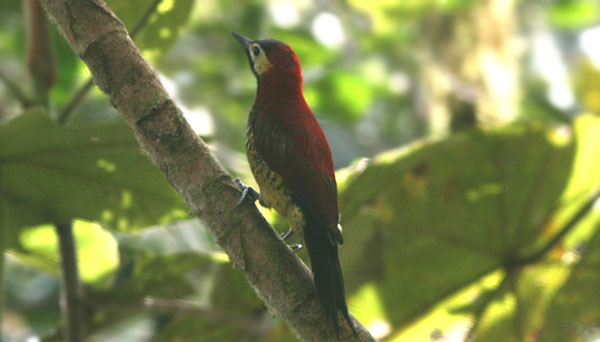
Crimson-mantled Woodpecker
As long as the light rain fell, we were only able to spy big birds like Andean Guan and Roadside Hawk. But once the precipitation tailed off, we were able to get into some decent late-day flocks. Almost imperceptibly, we tallied up a variety of warblers (Blackburnian, Spectacled Whitestart, and Slate-collared Whitestart), euphonias (Thick-billed and Golden-rumped), thrushes (Swainson’s and Glossy-Black), and tyrannids. That last group caused us some predictable consternation but we did manage to identify easy ones like Dusky-capped Flycatcher and Tropical Kingbird as well as less familiar species like Streak-necked Flycatcher and White-banded Tyrannulet.
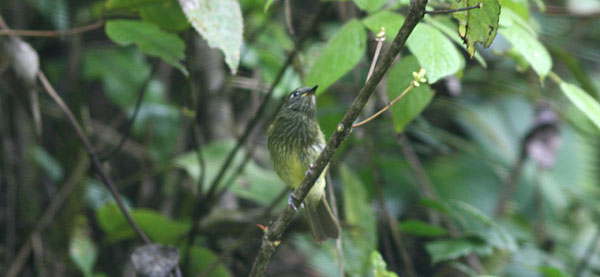
Streak-necked Flycatcher
We kept picking along, a Brown-capped Vireo here or a Booted Rackettail there under an ever-present stream of Blue-and-white Swallows. However, the birding was best for us once we attained our lowest altitude. A flat open expanse with great sightlines and a babbling brook was guarded by a Black Phoebe, which looked rather different from the ones I’m used to in the U.S. My first Golden Tanager, a lovely, luminous, incredibly common Tangara species, was accompanied by many even more common Lemon-rumped Tanagers. A Squirrel Cuckoo lurked in a tall bush while flocks of Red-billed Parrots wheeled raucously overead. My photos of the experience are, for the most part, as dim and blurry as one would expect from cloudforest photography. Fortunately, this portrait of a female Red-headed Barbet, a bird in the toucan family, does the subject justice. You should see how splendid the male is!
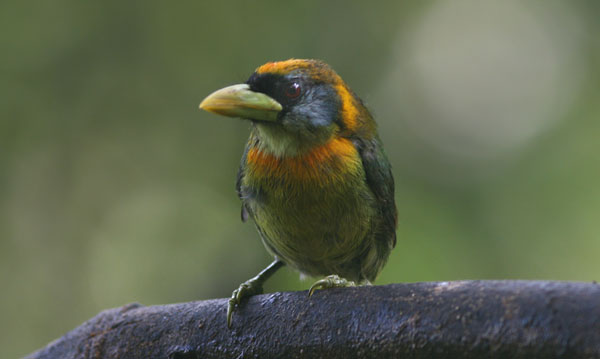
Red-headed Barbet (female)
To be honest, the Ecoroute was not my favorite Ecuadorean birding experience, but I’ve never been a fan of road birding. Nonetheless, the old Nono-Mindo Road deserves its reputation for amazing avifauna. We rode that winding, rural ruta late in the day under sub-optimal conditions and still picked up birds we didn’t see anywhere else. If we hit the road at daybreak, the take would have likely been doubled or tripled with ease. In any case, I highly recommend that all birders visiting the Quito area take a ride down the Ecoroute. After all, how often do you find roads dedicated to birding, in your country or any other?


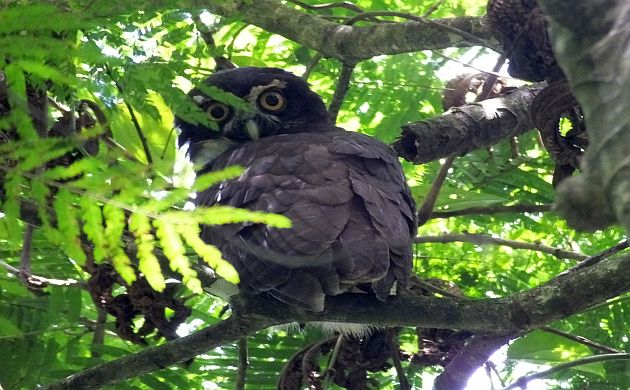

 New writers welcome – please contact us for details.
New writers welcome – please contact us for details.

















Nicely put Mike, this is an amazing road that takes you down from the highland to the sub-tropical forest in a couple of hours. This represents a nice oportunuty to see grear variety of birds.
Renato